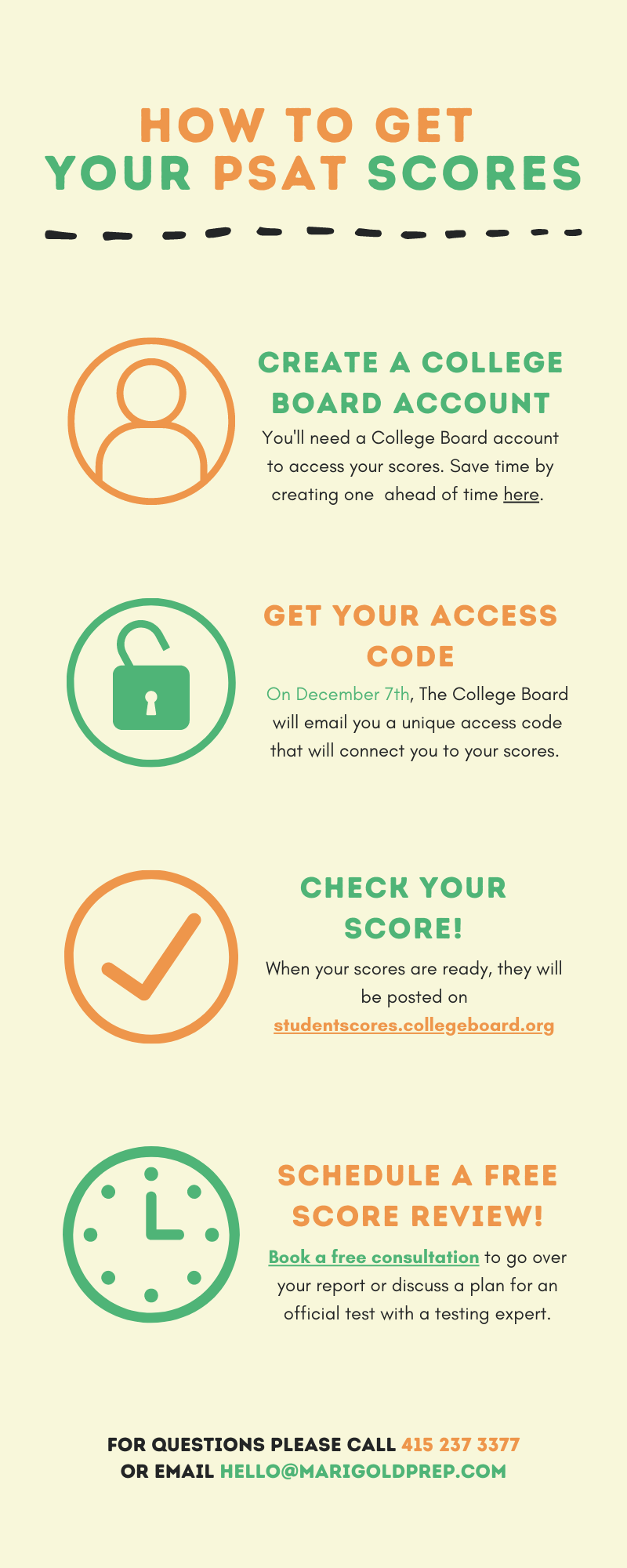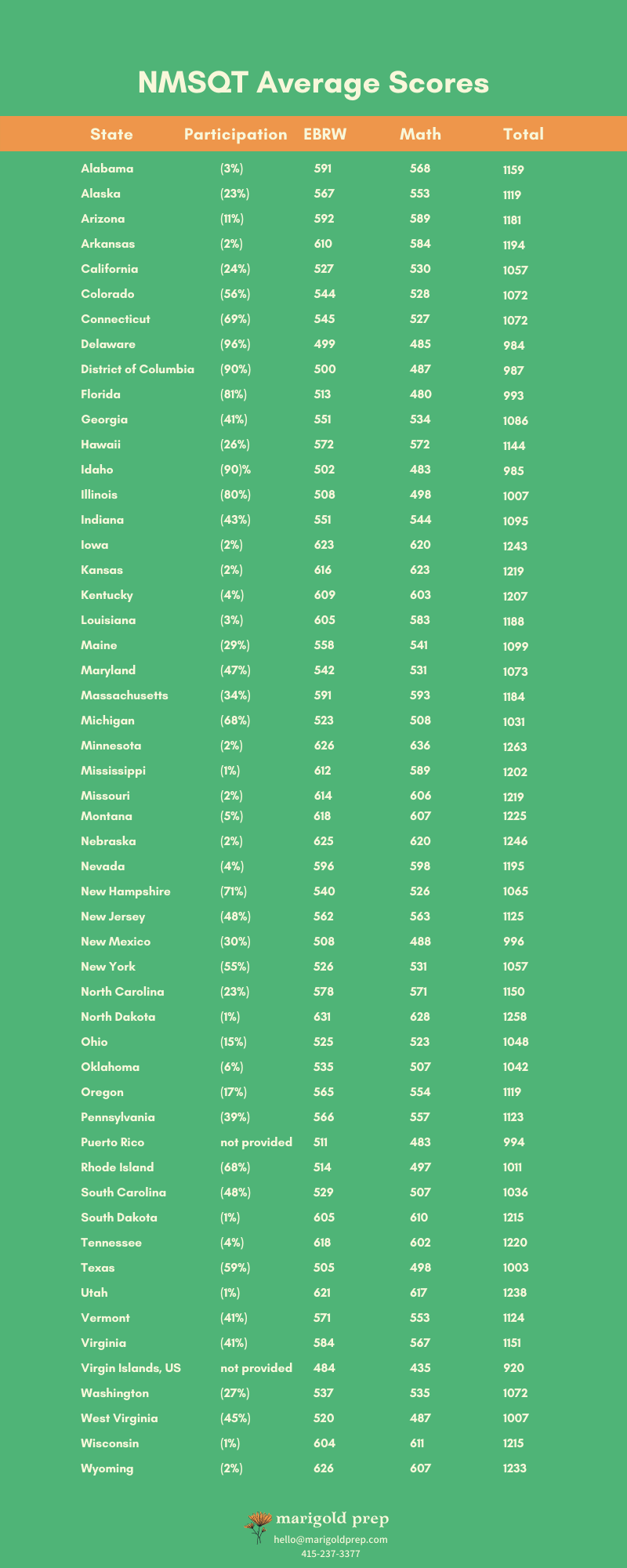So, I got my PSAT Score. Now what?
- Marigold Prep

- Dec 7, 2021
- 5 min read
Updated: Jan 25, 2022
On December 6th and 7th, students across the country received their PSAT scores. Both students and parents are now faced with trying to determine what those scores actually mean and what their next steps should be. So let’s talk through what the PSAT is, what the scores mean, how important they are, and what to do next.
How do I get my scores?
First and foremost, let's make sure you have your scores. Follow the instructions below to view your scores on The College Board's website.

How do I make sense of my PSAT score report?
There is valuable data on your score report that can help you determine if you're better suited for the SAT or ACT, what goals to target on official tests, and which date to register for. We've marked up the sample score report below, to give you a better idea of how to interpret your own.


Why did I take the PSAT?
Essentially, the PSAT is a test that gives students the chance to take a practice run at the actual SAT. The PSAT questions are formatted similarly to those on the SAT, and the material covered is similar. Students can take a PSAT as early as 8th grade in the form of the PSAT 8/9. Sophomores can take the PSAT 10, and juniors take the PSAT/NMSQT. As you would expect, the material on the PSAT 8/9 is slightly easier than that on the junior year PSAT. The timing varies a bit, as well.

You can see the PSAT 8/9 is less intense than the PSAT/NMSQT in terms of both questions and time. And all of these practice tests are slightly shorter than the official SAT.
They also differ in terms of score. The PSAT 8/9 is scored out of 1440 (720 verbal + 720 math), while the 10th and 11th grade tests are scored out of 1520 (760 verbal + 760 math). The official SAT is scored out of 1600 (800 verbal + 800 math).
The PSAT/NMSQT
While the PSAT 8/9 and PSAT 10 are purely practice runs at the SAT, the PSAT/NMSQT does have some potentially larger implications. The NMSQT designation stands for National Merit Scholarship Qualifying Test. The National Merit Scholarship is an award that juniors can qualify for by scoring in the top 1% of PSAT test takers in their respective states. The state by state differentiation is important, because average test scores vary widely by state.

These differences in score averages vary in part because of population, demographics, and the participation rate for each state. The National Merit cutoff score takes these differences into account.
The PSAT/NMSQT score report gives the overall score out of 1600 and the sectional breakdown between the verbal and math scores. It also provides another number known as the National Merit Index Score. This index score is calculated by taking each of the individual section scores for the PSAT into account. For example, if a student scored a 30 in the reading section, a 32 in writing/language, and a 600 in math, their National Merit index would be a 184 [(30 x 2) + (32 x 2) + 60]. This index score is the number used by the National Merit organization to determine which students move on as semi-finalists and which do not. The qualifying index changes year to year, as it’s based on that particular group of students in each state that took the test that year. For the class of 2022, the state with the highest qualifying index was Maryland (224). States like California (221), New York (220), and Texas (220) consistently rank among the those with the highest qualifying scores, making it more difficult to become a National Merit Semi-Finalist in those states.
Once a student becomes a semi-finalist, they then have several additional steps--including taking an official SAT or ACT--to attempt to become a finalist and, ultimately, a scholarship winner.
What is a “good” score?
Defining a “good” or “excellent” score is difficult, because it depends on the student. Generally speaking, a score of 1050-1100 (or above) on the PSAT 10 is considered good, and a student scoring in that range could potentially push for a National Merit-level score as a junior. But any sophomore scoring above 900 has done well.
On the PSAT/NMSQT, juniors scoring at or above 1000 have done well. The national average on the junior test hovers around 900, year to year. Scores above 1200 would be considered “excellent,” but even scores at that level are no guarantee of success on the official SAT. They can, however, give us an idea of where a student’s potential might lie.
The percentile conundrum
One of the bigger misconceptions about the various iterations of the PSAT involves percentiles. Percentile scores generally tell a test taker where they rank when compared to all the other test takers. So a 90th percentile would tell a student that they scored better than 90 percent of the other people taking the test. With the PSAT, however, College Board generates percentiles differently. In fact, College Board explains it this way:
“Nationally representative percentiles are derived from a research study of U.S. students in 10th or 11th grade and are weighted to represent all U.S. students in those grades, regardless of whether they typically take the PSAT/NMSQT or the PSAT 10.”
In other words, the PSAT percentile compares a student against all other students at that grade level, whether they took the PSAT or not. This creates a very misleading percentile score that skews higher than it should. For example, on a recent PSAT, a 530 verbal (reading + writing/language) score translated into a 71st percentile. A 71st percentile is far above average and would seem to put a student in a good position for success on the full SAT. However, a 530 verbal score generally ranks around the 50th to 55th percentile on the actual SAT--far closer to average than the student might think if they only looked at their PSAT report.
The moral of the story is that, while percentiles can be helpful indicators on the PSAT, they should definitely be taken with the proverbial grain of salt.
So, does the PSAT matter?
In short, yes. If a student is looking to be an elite-level scorer and make the National Merit threshold, a PSAT score can translate into a good amount of scholarship money. For example, the University of Alabama, the University of Florida, and the University of Arizona all offer full tuition plus other stipends just for becoming a National Merit finalist. Even without winning the National Merit scholarship, semi-finalists and finalists can gain huge benefit from hitting those qualifying scores.
For those students not looking for extremely high scores, the PSAT is still a great way to become acclimated to the SAT. It gives students a no-pressure dry run through the test format and material; test-taking experience is one of the best and most effective ways for students to begin to improve their scores on the SAT. And by using the score report students receive in December, students and their families can get a clear idea of the students’ strengths and challenges, and they can then move forward to create a plan to score well on the SAT.






Comments